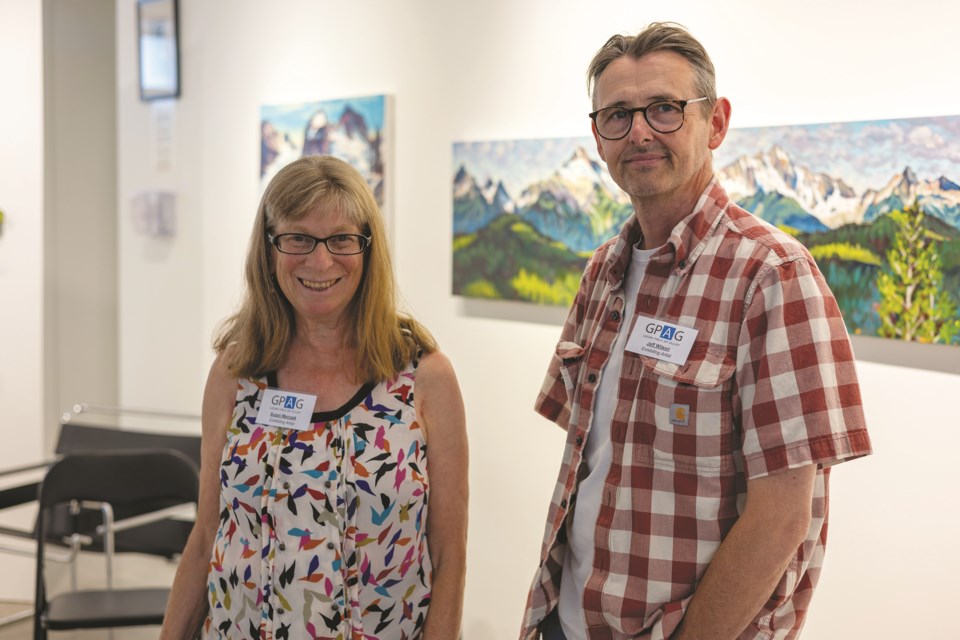Freshwater and tidewater flow through a new exhibition of paintings at the Gibsons Public Art Gallery, which opened with a public reception on Aug. 3 at the gallery’s downtown space.
A series of works by Lower Mainland-based artist Susan Marczak is titled Watershed. The immersive acrylic paintings are inspired by her first-hand rambles and ruminations in the backcountry as it is transformed by climate change. Across the gallery, North By Northwest — a series of large-scale works painted by Edinburgh-born Jeff Wilson — depict scenes of vitality and decay near the mouth of the Skeena River.
“I do a lot of hiking, and when you do a lot of hiking, you spend a lot of time around mountains and water,” Marczak said. “You start looking at where the water comes from. In the summers here, we’ve especially been noticing that water is getting more and more scarce.”
In Marczak’s landscapes, the mountain lakes and cloudless canopies are rendered in vivid sapphire, framed by sun-baked stone. In Birth of a River, the sun’s rays explode over a pyramid-like summit, lighting a mountainside glacier that sheds teal-green water. In From a Trickle, a tiny rivulet coursing down a rocky slope is bordered by alpine scrub. Imposing peaks above, their diamond-like facets washed in delicate pinks under cirrus clouds, add formidable contrast to the fragile flow.
“It’s worth knowing where water comes from, so we can appreciate it,” said Marczak, a graduate of Emily Carr University who has exhibited extensively throughout B.C. over the past 25 years.
The vulnerability of Sunshine Coast water sources became a focus of Marczak’s latest works as she explored the local backcountry. Her Chapman Diorama (formed of paper, acrylic paint and rigid foam) is a three-dimensional painting of the reservoir rendered in four distinct depths. As the viewer’s position changes, parallax effects give the work striking verisimilitude — all the more striking considering that the painter’s apparent perch atop Tetrahedron Peak was in fact realized through the assistance of Google Earth and a smartphone screen.
“A lot of these places are considered not particularly valuable,” Marczak added. “They don’t have timber, they don’t have good farmland. They don’t have much wildlife because they’re up in the alpine. But they’re definitely worth protecting and looking at.”
For Jeff Wilson, another Emily Carr graduate who has lived in Canada since 2004, a three-week residency at Cassiar Cannery in 2022 offered an opportunity to depict scenes where perceptions of value have shifted with time. In Underdock, sunlight gleams through the pilings of the long-defunct salmon cannery, located east of Prince Rupert. (The restored complex has provided rustic accommodations since 2006.) Wilson compared the many-pillared sight to the Grand Mosque in Córdoba, Spain. An overturned stump nursing new growth in a salt marsh (Up On the Downside) is painted with a richly-variegated palette, transitioning from shades of decay into tinctures of rebirth.
“What I’ve done is a series of paintings that illustrate different, specific aspects of the history and the culture of the landscape of the north coast of B.C.,” explained Wilson. During the residency (sponsored in part by the Prince Rupert Arts Council) he documented sights using photographs which he later synthesized into paintings.
“The north coast of B.C. is a particular part of the world,” Wilson observed in his artist’s statement. “[It] has evolved a particular character and mindset, due to the remoteness from the rest of the province.”
His views of staggered, polychromatic storefronts on Prince Rupert’s main street (Spring Evening, 3rd Avenue) and the rippled reflections of a cold storage plant in Seal Cove (Canadian Fishing) depict a region where a century of commercial frenzy and resource exploitation fades with solemn beauty.
Watershed and North By Northwest remain on display at the Gibsons Public Art Gallery until Aug. 25.



